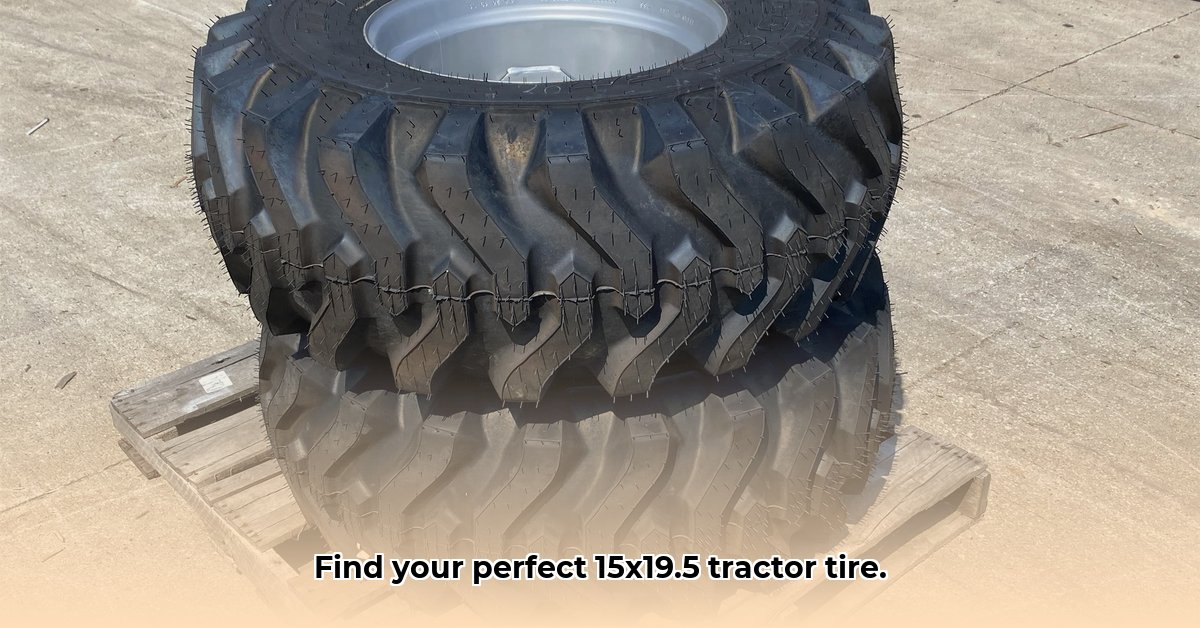
Understanding Your Tractor and Its Terrain
Choosing the right 15x19.5 tractor tire is crucial for efficiency and longevity. Before diving into specs, assess your tractor's workload. Will it primarily navigate soft fields, or tackle rough, rocky terrain? Heavy hauling demands robust tires built to withstand pressure, while mud necessitates superior traction. Understanding your operating conditions dictates the ideal tire choice. Are you primarily working in arable fields, or dealing with rougher terrain like rocky pastures or construction sites? This will influence your tire selection. For more detailed information on tire selection, check out this helpful resource: Tractor Tire Guide.
Decoding the 15x19.5 Designation: Size and Tread
The "15x19.5" denotes the tire's dimensions: a 15-inch rim diameter and a 19.5-inch cross-sectional width. This size is common in agricultural and construction equipment. The R-4 tread pattern, frequently found with these dimensions, offers a balance between traction and wear resistance. Consider the tread depth – deeper treads offer better grip, particularly in mud or loose soil, and enhance puncture resistance. Many R-4 tires also incorporate center tie bars, reducing vibrations for a smoother ride and enhanced operator comfort.
Ply Rating: Strength vs. Comfort
The ply rating indicates the number of fabric layers in the tire's construction. Higher ply ratings (e.g., 10-ply, 12-ply) signify increased strength and load-bearing capacity, ideal for heavy-duty applications. However, higher ply tires will be stiffer, sacrificing ride comfort. A 6-ply tire might suffice for light-duty work, while a 12-ply is better suited for heavy-duty use. What trade-off are you willing to make? Do you prioritize comfort or durability?
Quantifiable Fact: A 12-ply tire can typically handle significantly more weight compared to a 6-ply tire of the same size and construction.
Choosing Your 15x19.5 Tractor Tire: A Step-by-Step Guide
Selecting the perfect tire involves a methodical approach:
- Assess Workload: Accurately determine the weight your tires will regularly carry and the terrain type. Underestimating the load will lead to premature wear and potential tire failure.
- Choose Ply Rating: Select a ply rating to match the anticipated load and desired ride comfort. Consider your tolerance for a stiffer ride versus superior load capacity.
- Analyze Tread Pattern: The R-4 pattern is versatile, but consider alternative patterns (e.g., lug, rib) for specialized applications like mud or paved surfaces. A deeper tread depth provides better traction in muddy conditions.
- Evaluate Tire Compound: The rubber compound influences wear resistance and performance in various conditions. Look for compounds designed to withstand harsh conditions.
- Compare Prices and Warranties: While initial cost matters, factor in long-term costs. Evaluate warranties and choose durable tires that might save you money in the long run.
Data-backed Rhetorical Question: Wouldn't investing in a high-quality, durable tire that lasts longer ultimately save you more money than frequently replacing cheaper options?
Maintaining Your 15x19.5 Tires: Essential Maintenance
Regular maintenance is key:
- Air Pressure: Regularly check and adjust tire pressure according to the manufacturer's recommendations. Underinflation increases wear, fuel consumption and can damage the tire. Overinflation can also decrease tire life and reduce traction.
- Visual Inspections: Before each use, inspect for cuts, embedded objects, or irregular wear. Remove any debris promptly.
- Tire Rotation: Rotate tires as recommended in your tractor's manual to ensure even wear.
- Proper Storage: When storing tires, keep them in a cool, dry place to prevent damage.
Expert Quote: "Regular tire maintenance is not just about extending tire lifespan; it's about ensuring optimal tractor performance and operator safety," says Dr. Emily Carter, Agricultural Engineering Professor at Purdue University.
Comparing 15x19.5 Tires Across Brands: A Framework
While direct brand comparisons are limited by available data, this framework helps you navigate the options:
- Define Needs: Identify primary use (fieldwork, construction) to narrow down choices.
- Check Ply Ratings: Higher ply numbers (e.g., 8PR, 12PR) generally denote greater load capacity and durability.
- Analyze Tread Patterns: Select patterns optimized for your terrain.
- Research Manufacturers: Investigate reputable tire brands known for quality and longevity.
- Seek Reviews: Look for user feedback, though thorough independent reviews are often scarce for niche tire sizes.
- Balance Price/Availability: Find a balance between needed performance and budget.
Human Element: Consulting with experienced farmers or equipment operators in your area can provide invaluable insights based on their personal experiences with different brands and tire models.